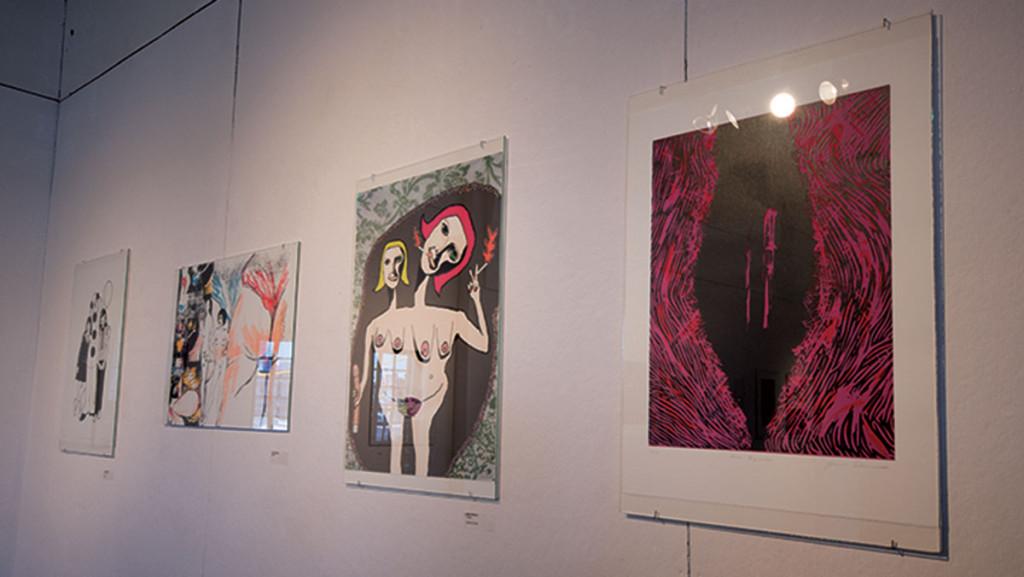Passing by prints of a colorful, bright landscape of snowy mountains, an orange astronaut on the moon and a black-and-white print of three boys posing in front of a car with the word “Kansas” underneath, the viewer walks upstairs and is confronted with a print of three monkeys laughing and pointing with a big, bold expletive underneath them.
The Ink Shop, a local Printmaking Center, is showing two new exhibits called “dirty pictures” and “Something About Mary.” Not only do these shows deeply explore the themes of what it means to be “dirty” and how a teacher affected her students, respectively, but also act as a tribute to the history and technique behind printmaking.
Both of these exhibits are portfolio pieces where a curator comes up with an idea for the show, gives it to many artists to explore and then collects the art back to be shown in the gallery. The idea behind portfolio pieces is the themes of the show are explored more broadly if 30 artists contribute one piece than if one artist constructs 30 pieces.
The idea for “dirty pictures” was first conceived in 1999 by Joshua McManus and Benjy Davies, graduate master of fine arts students at Ohio State University at the time, who contemplated the history of printmaking and the idea that anything could be interpreted as dirty. Davies said printmaking has a history of obscene art.
“Prints could be collected and could be stored privately, not on the wall like paintings, that are bigger and bulkier,” Davies said. “So early in printmaking, there was a history of erotic prints.”
In the history of woodblock, an early form of relief printing using wood, Japanese erotic art called Shunga prints started to become very popular in the Edo period, which lasted from 1603 to 1868. They were cheaper and more easily distributed than other forms of pornography at the time. This new form of pornography was a contributing factor to the rise of artistic printmaking today.
This portfolio tries to explore the roots of printmaking in a way that feels relevant to the world. In an age of unlimited pornography and advertisements that often feel like they are selling sex rather than a product, this exhibit opens a dialogue about what “dirty” means to the viewer.
“Dirty pictures” pushes boundaries and is intentionally uncomfortable. Every print feels like a well-rounded argument that contributes different view points to the greater discussion point set by the curator. The viewer comes out the other side feeling enriched, well versed and a little, well, dirty.
The prints range in tone, genre and value. They range in the types of prints: woodcut, silkscreen, etching and more. The portfolio style allows the exhibit to explore the abstract, blatant, light, dark, the sick and twisted, and the innocent. One print shows beetles copulating similar to images from the Kama Sutra. There is a print of a naked woman with phallic images drawn over her body. A pop-art piece is displayed of a naked man and woman staring into nothingness like Adam and Eve, along with a print of two girls and a clown posing for a photo with the title, “Get in the Van.”
All of these pieces, although very different, felt very cohesive when shown in one exhibit. For viewers, it may feel like every artist is having a conversation with the viewer about topics like sexuality, perversion, gender roles and censorship. With this in mind, Davies said portfolios provide a larger thematic range than most art shows.
“It is typical of a portfolio as a theme that everyone interprets the theme differently and you get a lot more variety than if you asked one person to make a series of prints about a certain thing,” Davies said.
That same feeling of variety and community is equally felt in the second exhibit, “Something About Mary.”
This portfolio was commissioned to explore how Mary Manusos, a professor at Ohio University for 35 years, has influenced the artists around her. Manusos, a printmaker herself, won the 2014 Outstanding Printmaker Award by the Mid America Print Council. Inez Flores, a historian and art critic, said Manusos’ art was filled with complexity and color.
“Her work embodies a complex pattern of meaning in spite of the apparent simplicity of the selected motifs,” Flores said. “The artist works on structures of perfectly organized compositions made up of overlapping planes and creative ambiances in a seductive, straight-forward play of vibrant colors.”
A print made by Manusos can be found in the “dirty pictures” exhibit where a young girl’s profile is drawn all in black on a tattered and faded background with the title, “Stolen.”
“Something About Mary” is a celebration of Manusos’ work as a teacher and artist, and an exploration of the technique of printmaking. Each piece feels like an example of how Manusos’ teaching affected the artist, no matter the style. From beautiful landscapes that show her use of color to colorful minimalist prints that represent her use of overlapping planes, it feels like a love letter to Manusos.
The risque and provocative complemented by the sweet and compassionate create an engaging and fascinating look into history and humanity. The Ink Shop has curated two great, thought-provoking exhibits that strikingly explore the greater themes of printmaking that are welcoming to novice and experience art-goers alike.
“Dirty pictures” and “Something about Mary” are being shown from Feb. 6–28.














